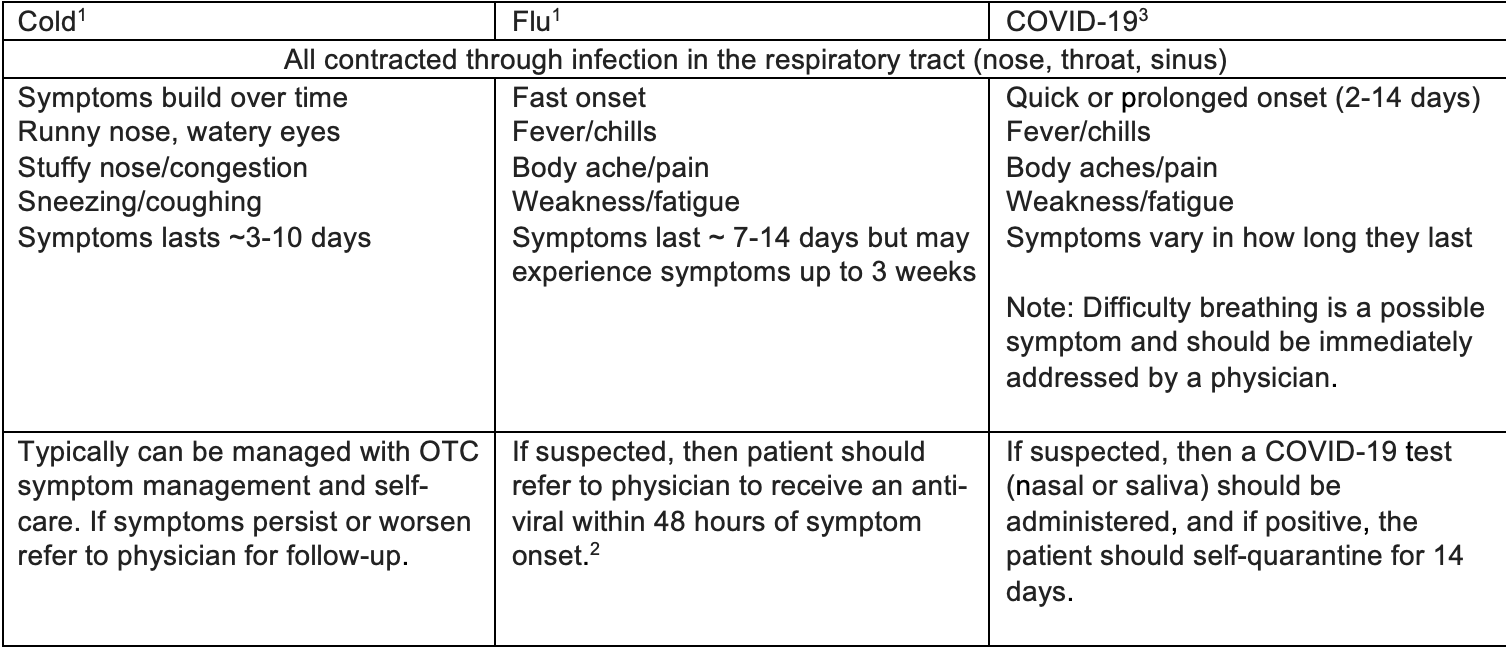Article
Symptom Comparison: Cold, Flu, and COVID-19
A few key points differentiate between the symptoms of a cold, flu, or possible COVID-19 infection.
As cold and flu season begins to pick up, patients are beginning to experience a myriad of symptoms and are seeking assistance identifying which possible illness they may have. Based on symptoms, there are a few key points to help differentiate a cold, flu, or possible COVID-19 infection.
In general, a cold has slower onset of symptoms and typically affects nasal sinuses. This is opposed to the flu, in which the symptoms tend to develop quickly while affecting the respiratory tract and tends to include body aches, fatigue, and fever.
COVID-19, however, can develop anywhere from 2 to 14 days post-exposure and tends to affect the respiratory tract along with body aches, fever, sore throat, and a new change to taste or smell. Importantly, if a patient is suspected to have COVID-19, it is recommended that the patient is tested to determine whether that is the cause of the symptoms.
If it’s positive, it’s important for the patient to self-quarantine and notify people they have been in close contact with who may have also been exposed. If at any time the patient is experiencing trouble breathing, they should be directed to the nearest emergency department (ED).
Recommendations to help reduce risk include getting the flu shot, being up-to-date on COVID-19 vaccinations, staying hydrated, covering coughs and sneezes, wearing a mask, practicing hand hygiene, sanitizing possibly infected surfaces frequently.
If the patient does experience symptoms of illness some possible recommendations include using OTC products to help manage symptoms, seeking help from a physician if symptoms are severe or do not subside with OTC intervention, talking with a physician if symptoms worsen or do not go away after 10 days of symptom management, and advising the patient to go to the ED if there are symptoms of difficulty breathing.
Click image to enlarge

Sources
1. https://www.cdc.gov/flu/symptoms/coldflu.htm
2. American Family Physician. “Influenza: Diagnosis and Treatment” David Y. Gaitonde, MD; Cpt. Faith C. Moore, USA, MC; and Maj. Mackenzie K. Morgan, USA, MC. https://www.aafp.org/afp/2019/1015/p505.htmPDF available at (https://www.aafp.org/dam/AAFP/documents/journals/afp/Influenza.pdf)
3. https://www.cdc.gov/coronavirus/2019-ncov/symptoms-testing/symptoms.html
About the Authors
Tiffany DiMaggio is a PharmD Candidate at Duquesne University in Pittsburgh, PA, anticipated to graduate in Spring 2022.
Jonathan Ogurchak, PharmD, CSP, is the CEO and cofounder of STACK, a pharmacy information management platform, and serves as preceptor for a virtual Advanced Pharmacy Practice Experiential Rotation for specialty pharmacy, during which this article was composed.





